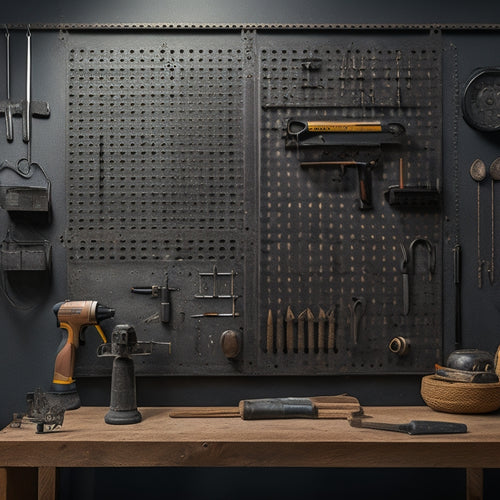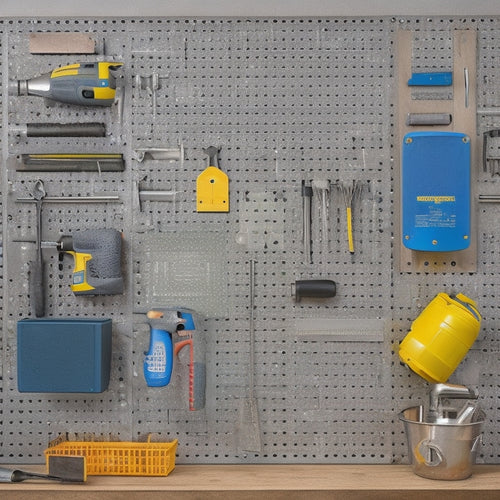
5 Essential Tool Storage Hacks for Small Business
Share
You can boost your workshop's productivity with these 5 essential tool storage hacks. First, maximize vertical space by installing wall-mounted shelves and hooks to store bulky items and small parts. Next, utilize hidden storage areas like under-shelf compartments and behind-the-door storage for extension cords. Organize tools by category, frequency, and type to reduce frustration. Invest in durable portable storage containers with secure latches and handles. Finally, label and sign everything using a standardized system to improve efficiency. By implementing these hacks, you'll be well on your way to a clutter-free workshop where every tool has its place, and you can focus on getting the job done - and that's just the beginning.
Key Takeaways
• Maximize vertical space with wall-mounted shelves, hooks, or pegboards to double storage capacity without sacrificing floor space.
• Utilize hidden storage areas like under-shelf compartments, behind-the-door storage, and secret compartments in furniture to optimize space.
• Organize tools by category, grouping similar tools together, to reduce frustration and save time when searching for tools.
• Invest in durable, portable storage containers with secure latches and handles to stay organized and increase productivity on-the-go.
• Label and sign everything, using a standardized system, to improve efficiency and quickly identify tools and storage containers.
Maximize Vertical Space Storage
Install wall-mounted shelves, hooks, or pegboards to capitalize on the often-wasted vertical space in your workshop or storage area, doubling your storage capacity without sacrificing valuable floor space. This hack is especially useful when you have limited floor space or need to store bulky items like ladders, pipes, or equipment.
For instance, consider installing wall shelves to store bins, baskets, or containers filled with small parts, tools, or accessories. You can also use ceiling hooks to hang items like bikes, kayaks, or even heavy tools, freeing up floor space and keeping them out of the way.
To take it a step further, consider using pegboards with hooks, bins, and accessories specifically designed for tool storage. This will allow you to customize your storage system and keep frequently used tools within easy reach.
Additionally, label each shelf, hook, or bin to make sure you can quickly find what you need, saving you time and increasing productivity. By maximizing your vertical space, you'll be able to store more tools and equipment in a smaller area, making your workshop or storage area more efficient and organized.
Utilize Hidden Storage Areas
Utilize Hidden Storage Areas
By thinking outside the box and exploring every nook and cranny, you can uncover hidden storage areas that can help you stash away tools, equipment, and supplies, keeping your workshop or storage area clutter-free and organized. One of the most effective ways to do this is by identifying and utilizing dead space in your workshop or storage area.
| Hidden Storage Area | Description | Tools/Supplies to Store |
|---|---|---|
| Under-shelf compartments | Install shelves with removable tops or sliding drawers | Small hand tools, fasteners, adhesives |
| Behind-the-door storage | Use over-the-door organizers or hooks | extension cords, hoses, safety gear |
| Hollowed-out furniture | Convert old furniture into secret compartments | valuable or sensitive tools, equipment manuals |
| Ceiling-mounted storage | Install hooks or bins from the ceiling | infrequently used tools, seasonal equipment |
| Inside cabinet organizers | Add dividers, baskets, or shelves inside cabinets | cleaning supplies, paints, chemicals |
Organize Tools by Category
By categorizing your tools into groups based on their function, type, or frequency of use, you can create a system that allows you to quickly locate and access the tools you need, when you need them. This tool categorization will save you time and reduce frustration.
Start by grouping similar tools together, such as all your wrenches or pliers. Then, organize them further by frequency of use. For example, you might have a section for frequently used tools, like your trusty hammer, and another for less frequently used tools, like your specialized socket set.
Frequency grouping is especially helpful for tools that you use daily or weekly. By keeping these tools in easy-to-reach locations, you'll save time and energy. You can also categorize tools by the project or task they're used for. For instance, you might have a section for tools used for plumbing, electrical work, or carpentry.
Invest in Portable Storage
Now that you've organized your tools, it's time to think about how you'll store and transport them, and that's where portable storage solutions come in. You need a system that allows you to easily move your tools from the warehouse to the job site without damaging them or wasting time. Invest in high-quality, durable portable storage containers that can withstand the rigors of daily use. Consider chests, cabinets, or boxes with secure latches and handles that make them easy to carry.
When choosing portable storage solutions, think about your fleet management needs. Will you need to transport tools in a truck or van? Do you have limited storage space at the job site? Look for containers that are designed specifically for your industry and can be easily stacked or secured in your vehicles.
Portable storage solutions will help you stay organized, reduce downtime, and increase productivity. By having the right tools at the right time, you'll be able to complete jobs more efficiently and effectively, giving you a competitive edge in your industry.
Label and Sign Everything
Clear labeling and signage are essential for quick tool identification, reducing confusion, and saving time when searching for specific equipment in your portable storage containers. You'll be amazed at how much more efficient you'll become when everything has its designated place and label.
Here are some tips to take your labeling game to the next level:
-
Color Coding: Use different colors to categorize tools by type, brand, or frequency of use. This visual system will help you quickly identify what you need.
-
Digital Labels: Invest in a label maker that can print digital labels. These are easy to read, and you can customize them with relevant information like tool names, dates, or maintenance records.
-
Create a Standardized Labeling System: Establish a consistent format for your labels, including font, size, and layout. This will make it easy to scan and find what you need.
- Sign Your Containers: Don't just stop at labeling individual tools. Sign your portable storage containers to indicate what's inside, making it easy to grab what you need on the go.
Frequently Asked Questions
How Often Should I Clean and Maintain My Tool Storage System?
You should clean and maintain your tool storage system daily by tidying up and weekly by reorganizing, and schedule regular audits every 3-6 months to make sure everything is in its place and functioning efficiently.
Can I Customize My Storage System to Fit My Business's Specific Needs?
You can customize your storage system a million times over to fit your business's specific needs! Start with a thorough business analysis to identify your unique requirements, then optimize your space to maximize efficiency and productivity.
Are There Any Safety Considerations for Storing Hazardous Materials?
"When storing hazardous materials, you'll want to prioritize safety by ensuring Material Labeling is accurate and Regulatory Compliance is met, so you're prepared in case of an emergency and avoid costly fines."
How Can I Prevent Tool Theft or Loss in the Workplace?
You can prevent tool theft or loss by using secure containers with labeled inventory, assigning tools to specific employees, and implementing a check-out system to promote employee accountability.
Are There Any Tool Storage Hacks for Businesses With Limited Budgets?
You can find budget-friendly solutions for tool storage by repurposing containers like old pallets, crates, or even plastic bins, which can be labeled and secured to prevent theft and keep your tools organized.
Related Posts
-

What to Look for in a Pegboard Tool Storage Kit
When shopping for a pegboard tool storage kit, you need a system that combines customized organization, sturdy durabi...
-

Heavy-Duty Pegboard Hooks for Industrial Use
You need heavy-duty pegboard hooks that can withstand the rigors of industrial use, providing a reliable and efficien...
-

How to Hang a Pegboard in 5 Easy Steps
You'll hang a pegboard in 5 easy steps by first preparing the wall, ensuring it's sturdy and free of obstructions. Ne...


